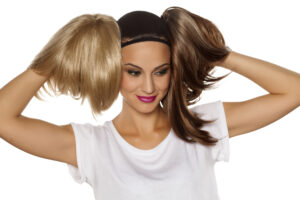The Different Types of Wigs
To meet everyone’s needs, there are different types of wigs. To help you make an informed choice, our experts have prepared a brief summary of their design (hair and cap), and the advantages and disadvantages of each.
Synthetic hair wigs
There are many advantages to choosing a wig made from synthetic hair. First, it’s less expensive to buy, easy to care for, and requires no styling skills. After washing, the hair will return to its original shape when drying. Therefore, when buying synthetic wigs, it’s important to choose a hairstyle you like, as you won’t be able to change it.
It’s also important to know that synthetic hair doesn’t tolerate heat, so you won’t be able to use an iron, a dryer or even go near an oven or BBQ. Heat will permanently damage the synthetic hair fibers. We don’t recommend wearing a mid-length or long, 100% synthetic-hair wig in the winter, because like fake-fur collars, the hair tends to tangle. Wigs should be cared for with products designed for synthetic hair.
Advances in design have made it possible to create a synthetic fiber that is similar in appearance to natural hair.
High-heat synthetic hair wigs
High-heat fibers are better quality and more resistant. You can use styling tools at low temperatures, up to 300 degrees Fahrenheit. This fiber blend offers a more natural look than standard synthetic fibers.
Natural hair wigs
Just like synthetic hair, there are many different qualities and types of natural hair. Natural hair wigs give you the sensation of wearing your own hair. You can curl your hair and style it as you wish with your usual styling products and tools. Natural hair is heat-tolerant. You don’t need to worry about this factor.
However, you do need to be very skilled when styling natural hair, as it requires a certain amount of skill. Our experts can provide maintenance and styling services. The fact that the fiber is natural is a big drawback when it comes to price. Natural hair wigs are much more expensive than synthetic fiber wigs due to their rarity.
‘Blend’ wigs
This type of wig is made from 30% natural hair and 70% high-heat synthetic hair. Blend wigs give you the feel of natural hair and the ability to recreate the looks you want. You’ll get the quality and look of natural hair at a lower cost.
Medical wigs
When you have permanent and complete alopecia, we suggest a medical wig since it offers superior stability. Medical wigs are designed with a material that reacts to your body heat. This non-slip material adheres perfectly to the head, just like a glove, and stays in place all day long.
The cost of purchasing this type of wig is higher, since it is generally made from natural hair. On the other hand, this type of wig is not recommended for women undergoing chemotherapy. Wearing it will become painful as the hair grows back. The non-slip material in the cap will pull the hair back.

Lace front wig caps
Wig caps with a lace front are virtually undetectable and blend in perfectly with the skin. What’s more, they offer maximum comfort for daily wear. The hair is hand-tied on this part of the cap.
Monofilament top wig caps
When a wig is made with a monofilament cap on top, it assures an authentic scalp appearance. The hair is hand-tied one by one. Knots are undetectable for the most natural effect, especially if you style with a well-defined parting.
Machine-made caps
As the name suggests, the hair is sewn to thin strips of fabric. These strips are all bound together to give the hair a natural movement. Most caps with a lace front or monofilament top have the back of the cap machine-made. Machine-made caps are less expensive than other types of wig caps.
Our experts are here to advise you on the best option for you. Our specialists will give you the style you want, down to the smallest detail: color, length, texture, density, curl and much more…
Book an appointment now or visit our Online Store to see the available models.


